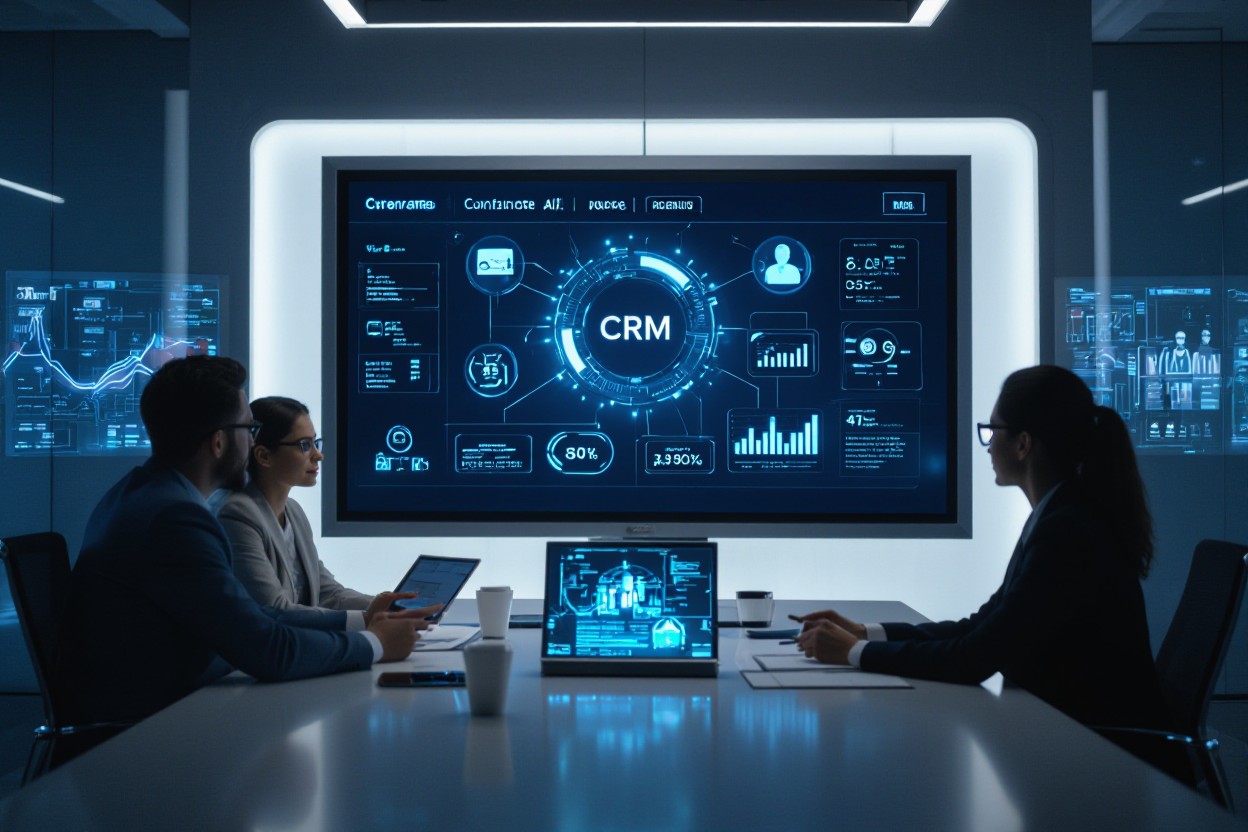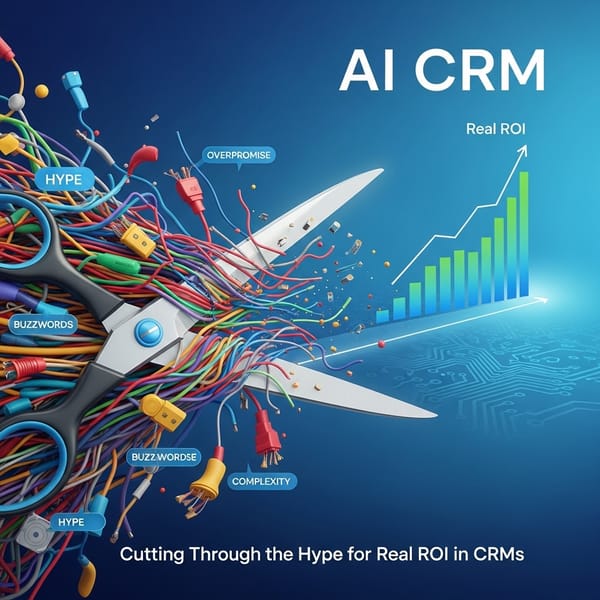What Is AI-Powered CRM and Why Your Agency Needs It in 2025

Most agencies are moving beyond manual systems as AI-powered CRM combines customer data, predictive analytics, and automation to streamline workflows, personalize outreach, and increase retention; you gain real-time insights, smarter lead scoring, and automated follow-ups that free your team to focus on strategy, while measurable ROI and competitive differentiation make adoption a strategic imperative for your agency in 2025.
Key Takeaways:
- AI-powered CRM combines customer data, machine learning, and automation to deliver predictive insights and personalized client interactions.
- Automates routine tasks (lead scoring, follow-ups, pipeline updates), freeing agency staff for creative and strategic work.
- Drives revenue through better targeting, higher conversion rates, and improved client retention via real-time personalization.
- Integrates with existing tools and amplifies data-driven decision-making, but requires clean data and clear change management for adoption.
- Offers measurable ROI by reducing operational costs and improving campaign performance—plan phased rollout, training, and privacy-compliant data governance.

The Future of Customer Engagement: AI's Transformative Role
AI shifts engagement from campaign-driven pushes to continuous, context-aware conversations, letting you predict intent, automate routine tasks, and surface the right offer at the right moment. Firms using recommendation engines like Amazon (which attributes roughly 35% of sales to personalization) show how tailored experiences lift revenue and loyalty; your agency can replicate that by combining real-time signals, predictive scoring, and automated orchestration across chat, email, and voice channels.
Changing Consumer Expectations in 2025
Consumers now expect immediate, personalized interactions across channels—chat, voice, social, and in-app—matching experiences from Netflix and Spotify where content is curated per user. You’ll face demand for frictionless self-service, faster resolution times, and privacy-aware personalization; agencies that fail to provide omnichannel continuity and contextual relevance will lose share to competitors who deliver seamless, tailored journeys.
Enhancing Personalization Through Data Insights
Personalization relies on unified customer profiles that combine CRM, behavioral, and transactional data to power real-time recommendations and propensity models; you should use feature stores and event streaming to update segments in seconds. Adaptive content rules + ML-driven scoring let you serve different creatives, offers, and channels per user, improving relevance while reducing wasted spend.
Operationalizing this means instrumenting touchpoints (web, app, call center), creating a single customer graph, and training models for churn, lifetime value, and next-best-action. For example, an ecommerce client you manage can lift AOV and repeat purchase rates by feeding 90-day purchase recency, browse signals, and promo sensitivity into a real-time recommender, running A/B tests, and iterating model thresholds based on conversion lift rather than vanity metrics.
The Mechanics of AI-Driven CRM Systems
Data pipelines ingest customer interactions from emails, chat, form fills, and call transcripts; embeddings and vector stores (FAISS, Pinecone) enable semantic search; transformer-based LLMs or smaller fine-tuned models generate summaries, next-action suggestions, and content; orchestration layers handle routing and latency targets under 200–500 ms for real-time flows; monitoring captures model drift and feedback loops so you can retrain on fresh labeled CRM data while enforcing encryption and role-based access for PII.
Key Features That Set AI Solutions Apart
Predictive lead scoring, intent detection, and dynamic personalization let you target high-value prospects with tailored sequences; automated agent assist and summarization cut handling time, while intent routing and sentiment analysis improve triage; workflow automation ties actions to predicted outcomes so you can scale outreach with consistent brand voice and compliance.
- Predictive lead scoring using dozens of behavioral, firmographic, and engagement signals to rank opportunities.
- Real-time intent detection and routing that pushes hot leads to reps within seconds via webhooks.
- Automated content generation (emails, replies, proposals) with templates and guardrails to enforce tone and compliance.
- Conversation summarization and action extraction that reduce manual note-taking and improve CRM data quality.
- Personalization at scale using customer embeddings to tailor offers across channels.
- Thou enable audit trails and human-in-the-loop controls to ensure explainability and corrective feedback.
Integrating AI with Existing CRM Platforms
You can add AI via API connectors, middleware (MuleSoft, Zapier, Workato), or native plugins (Salesforce Einstein, HubSpot AI) without replacing your CRM; choose between batch enrichment jobs for nightly scoring or streaming webhooks for live routing, map fields to canonical schemas, and sandbox integrations to validate data fidelity before going live.
Start with a narrow pilot—5–10% of contacts or a single sales pod—measure lift on KPIs like conversion rate, response time, and AHT (average handle time), then iterate: instrument A/B tests, log false positives for retraining, tune model thresholds to balance precision/recall, and ensure encryption-at-rest, scoped API keys, and periodic access reviews to meet compliance requirements.
Unlocking Operational Efficiency: Automation in CRM
Automation slashes repetitive work across your agency by turning routing, follow-ups, invoicing, and reporting into hands-off processes. Automating lead qualification and routing can cut response time from 24 hours to under 1 hour and often boosts conversion rates by 20–30%. Implementing AI workflows freed up account teams in multiple agencies to reclaim 10–15 billable hours per week, letting you shift focus from admin to strategy and scale without linear headcount growth.
Streamlining Processes with AI-Driven Automation
AI-driven automation lets you set behavior-based triggers: tag a prospect after three site visits, push hot leads to senior AEs, and launch tailored nurture sequences automatically. Chatbots handle routine queries—resolving up to 40% of first-touch questions—while dynamic task queues prioritize work by lifetime value, not arrival time. These features reduce manual triage, cut average handle time, and ensure your best talent works on the highest-impact opportunities.
Predictive Analytics: The Game Changer for Agencies
Predictive models score leads, forecast churn, and estimate campaign ROI so you can act proactively instead of reactively. A reliable propensity-to-buy model helps you focus on the top 10–20% of prospects that drive most revenue, increasing close rates by double digits. Feeding engagement, firmographic, and purchase-history signals into these models turns raw CRM data into prioritized, revenue-driving actions for your teams.
Operationalizing predictive analytics means building pipelines that convert scores into playbooks: an 80+ propensity lead triggers an immediate SDR outreach, a falling-retention score starts a renewal campaign with discounts and CSM intervention. Track model performance with precision, recall, and lift; retrain monthly with recent outcomes to avoid drift. Agencies that follow this loop often see measurable gains—one example: prioritizing top-decile leads lifted quarterly revenue by ~15% within six months—by aligning people and processes to prediction outputs.

Real-World Success: Agencies Thriving with AI CRM
Agencies that have adopted AI-powered CRM report measurable gains: typical pilots deliver 10–30% higher conversion rates, a 20–40% reduction in manual admin, and faster deal cycles—often within 3–6 months. You’ll notice improved forecasting accuracy, more predictable revenue, and freed-up account-manager time that lets your team focus on strategic growth rather than data entry.
Notable Examples of Impact and Growth
A mid-size digital agency implemented predictive lead scoring and doubled lead-to-close rates from 8% to 16% within six months, while a boutique PR firm used automated nurture flows to cut client churn by 30% year-over-year. A global marketing shop slashed campaign turnaround by 40% after integrating AI-driven brief generation and asset tagging, enabling you to scale creative output without proportional headcount increases.
Lessons Learned from Early Adopters
Early adopters show you should start with high-value use cases, like lead scoring or churn prediction, run short pilots, and prioritize data hygiene; one agency reclaimed 20% of account managers’ time after automating administrative workflows. You’ll avoid costly scope creep by defining KPIs, limiting integrations initially, and measuring lift against a control group.
Practical steps you can follow: run a 6–12 week pilot with a defined cohort, clean top CRM fields (contact info, deal stage, value), integrate the CRM with 1–2 core tools, and assign an AI champion. Train staff 3–5 hours weekly during rollout, enforce data governance and consent tracking, and monitor model performance monthly—expect initial uplifts of 10–25% and iterate from real ROI signals.
Steps to Transition: Implementing AI-Powered CRM
You conduct a data audit, define high-value AI use cases (lead scoring, chat automation, churn prediction), shortlist vendors, run a 10–20% pilot over 60–90 days, and measure KPIs like response time (target −40%), lead conversion (+15%), and time-to-close. You allocate 8–16 training hours per role and plan a phased, API-driven rollout to avoid downtime. Agencies integrating Salesforce Einstein or HubSpot AI often report 30–50% reductions in manual triage—use those benchmarks to set your targets.
Evaluating Your Agency's Needs for AI Solutions
You audit your CRM for data quality (aim for >80% populated key fields), list pain points—sales outreach bottlenecks, support SLAs, reporting lag—and prioritize use cases with clear ROI (e.g., 15% higher conversion or 20% fewer support tickets). You verify API access, security controls, and vendor case studies; pilot budgets commonly run $5k–$20k. Decide whether to buy (Salesforce, HubSpot, Zoho) or build, factoring integration time and compliance like GDPR.
Best Practices for a Smooth Integration
You map and clean fields first—standardize formats and remove duplicates—then build a sandbox for 4–6 weeks of testing. You deploy in phases by team or region, assign SLAs for AI suggestions, and run weekly KPI checks (adoption rate, accuracy, time saved). You train power users with 8–12 hours of hands-on sessions, collect feedback via twice-weekly check-ins, and require measurable improvement thresholds before scaling.
You link source system IDs to a canonical customer ID and map lead_score to priority and account_value to segmentation buckets. You run deduplication to remove ~30% redundant records, back up full datasets, and create rollback scripts. You validate model precision and recall in the sandbox—target >80% precision for intent classification—and set adoption targets (70% active use within 60 days) with clear incentives and reporting dashboards.
To wrap up
On the whole, AI-powered CRM combines predictive analytics, automation, and real-time insights to streamline workflows, improve client targeting, and boost retention. By 2025, it enables you to scale operations, make faster data-driven decisions, and deliver hyper-personalized experiences that set your agency apart in a crowded market.
FAQ
Q: What is AI-powered CRM and how does it differ from traditional CRM?
A: AI-powered CRM combines core CRM functions (contact management, pipeline tracking, activity history) with artificial intelligence technologies — machine learning for predictive scoring, natural language processing for sentiment and intent detection, recommendation engines for next-best actions, and automation for routine workflows. Unlike traditional CRMs that mainly record and retrieve data, AI-powered systems analyze patterns in both structured and unstructured data, surface prioritized insights, automate repetitive tasks, and generate prescriptive recommendations that help teams act faster and more accurately.
Q: Why should an agency adopt AI-powered CRM in 2025?
A: In 2025 agencies face higher client expectations, data volume growth, and demand for measurable outcomes. AI-powered CRM enables hyper-personalized outreach at scale, predicts lead quality and churn risk, automates proposal and follow-up sequences, and optimizes resource allocation across campaigns. It reduces time to close by surfacing high-propensity opportunities, improves retention through proactive interventions, and speeds creative and media testing cycles by identifying which messages and channels drive ROI. The net effect is higher conversion and lifetime value with lower manual effort.
Q: What data, integrations, and preparation are needed for a successful deployment?
A: Successful deployment requires consolidated, high-quality data: CRM records, marketing engagement (email, forms, ads), billing/ERP data, web and app analytics, social interactions, and call/chat transcripts. Integrations via APIs or middleware (CDP, iPaaS) to your ad platforms, marketing automation, finance, and support tools are vital. Prep work includes deduplicating records, standardizing fields and taxonomies, tagging key events, mapping customer journeys, and establishing data governance (access controls, retention policies). A phased approach beginning with a clean pilot dataset reduces time-to-value.
Q: How do I evaluate vendors and plan implementation without disrupting agency operations?
A: Evaluate vendors on AI capabilities (predictive scoring, NLP, explainability), pre-built industry models, integration ease (connectors, APIs), customization, security and compliance certifications, SLAs, and total cost of ownership. Request case studies and run a short pilot targeting a single use case (lead scoring or automated nurturing) with measurable KPIs. Implementation best practices: define success metrics, assign a cross-functional sponsor team, train users on new workflows, keep humans in the loop for decisions, iterate on model thresholds, and roll out in stages to limit operational risk and ensure adoption.
Q: What ROI metrics should an agency track and what risks must be managed?
A: Track conversion rate lift, lead-to-client velocity, average deal size, client retention/churn rate, campaign ROI, agent productivity (time saved per task), response time, and customer satisfaction (CSAT/NPS). Key risks include biased or low-quality data causing poor recommendations, data privacy and compliance breaches, model drift as behavior changes, over-automation that harms relationships, and vendor lock-in. Mitigations: enforce data quality processes, perform bias and performance audits, maintain human oversight for critical decisions, encrypt and monitor data flows, implement contractual exit and portability terms, and schedule regular model retraining and validation.





